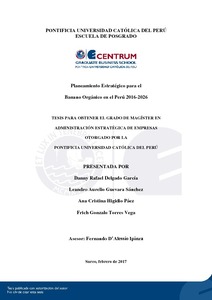| dc.contributor.advisor | D´Alessio Ipinza, Fernando Antonio | |
| dc.contributor.author | Delgado García, Danny Rafael | es_ES |
| dc.contributor.author | Guevara Sánchez, Leandro Aurelio | es_ES |
| dc.contributor.author | Higidio Páez, Ana Cristina | es_ES |
| dc.contributor.author | Torres Vega, Frich Gonzalo | es_ES |
| dc.date.accessioned | 2017-03-09T21:44:27Z | |
| dc.date.available | 2017-03-09T21:44:27Z | |
| dc.date.created | 2017 | |
| dc.date.issued | 2017-03-09 | |
| dc.identifier.uri | http://hdl.handle.net/20.500.12404/8115 | |
| dc.description.abstract | El presente documento es un plan estratégico que se ha elaborado para que el Banano
Orgánico en el Perú desarrolle ventajas competitivas al 2026. Se ha utilizado la metodología
del modelo secuencial creado por D’Alessio (2015), que consiste en una serie de pasos que se
inicia con la auditoría externa e interna. Se encontró que la principal fortaleza de la
organización es la existencia de asociaciones de productores, lo cual ha permitido crear
sinergias, y con ello aprovechar la oportunidad de tener acceso a un mercado mundial de
productos orgánicos en expansión, debido a la tendencia de consumir productos saludables.
Para el año 2026, el Banano Orgánico en el Perú se habrá posicionado como el primer país
exportador en el mundo, alcanzando ventas superiores a los US$ 500 millones, lo cual
beneficiará a los productores que, a través de las asociaciones, tendrán acceso a tecnología,
capacitación y crédito, incrementando así el rendimiento por hectárea. Estos beneficios
permitirán mejorar la calidad de vida de las familias de los productores de Banano Orgánico
del Perú por medio del incremento en el nivel educativo. Los objetivos de largo plazo se
alcanzarán mediante la implementación de estrategias como la de incrementar las
exportaciones de Banano Orgánico a los principales países compradores, que son Estados
Unidos, Holanda, Alemania y Bélgica. Asimismo, se desarrollarán nuevos mercados en
países asiáticos, aprovechando los tratados de libre comercio que el Perú ha suscrito, y se
incrementará el número de productores asociados para expandir el acceso a certificaciones
mediante el impulso de la investigación. Todo esto se seguirá de una manera coordinada, bajo
el liderazgo de una junta directiva que sea designada por todas las asociaciones dedicadas a la
producción y comercialización de Banano Orgánico en el país | es_ES |
| dc.description.abstract | The present document is a strategic plan that has been elaborated for the development of
competitive advantages by the Organic Banana in Peru at 2026. The methodology applied is
the sequential model, created by D'Alessio (2015), which consists on consecutive steps,
starting with external and internal audits. There was found that the main strength of the
organization is the existence of producers’ associations, which have allowed to create
synergies, taking advantage of the opportunity to have access to global markets of organic
products that are in expansion, due to a healthy trend. By 2026, Peru will have positioned
itself as the first exporting country in the world for Organic Bananas, reaching sales over US$
500 million. This will benefit producers, who through the associations will have access to
technology, training and credit, incrementing yield per hectare. These benefits will improve
the quality of life of the families of organic banana producers in Peru through an increase in
the educational level. The long-term objectives will be achieved through the implementation
of strategies such as increasing Banana Organic exports to the main purchasing countries,
which are the United States, the Netherlands, Germany and Belgium. Likewise, new markets
will be developed in Asian countries, taking advantage of the Free Trade Agreements that
Peru has signed and the number of associated producers will increase to expand the access to
certifications, promoting research. All this in a coordinated way, under the leadership of a
Board of Directors that is designated by all the associations dedicated to the production and
commercialization of Organic Bananas in the country | es_ES |
| dc.language.iso | spa | es_ES |
| dc.publisher | Pontificia Universidad Católica del Perú | es_ES |
| dc.rights | Atribución-NoComercial-SinDerivadas 2.5 Perú | * |
| dc.rights | info:eu-repo/semantics/openAccess | es_ES |
| dc.rights.uri | http://creativecommons.org/licenses/by-nc-nd/2.5/pe/ | * |
| dc.subject | Bananos | es_ES |
| dc.subject | Agroindustria | es_ES |
| dc.subject | Planificación estratégica | es_ES |
| dc.title | Planeamiento estratégico para el banano orgánico en el Perú 2016-2026 | es_ES |
| dc.type | info:eu-repo/semantics/masterThesis | es_ES |
| thesis.degree.name | Magíster en Administración Estratégica de Empresas | es_ES |
| thesis.degree.level | Maestría | es_ES |
| thesis.degree.grantor | Pontificia Universidad Católica del Perú. CENTRUM | es_ES |
| thesis.degree.discipline | Administración Estratégica de Empresas | es_ES |
| renati.discipline | 413307 | es_ES |
| renati.level | https://purl.org/pe-repo/renati/level#maestro | es_ES |
| renati.type | https://purl.org/pe-repo/renati/type#tesis | es_ES |
| dc.publisher.country | PE | es_ES |
| dc.subject.ocde | https://purl.org/pe-repo/ocde/ford#5.02.04 | es_ES |






